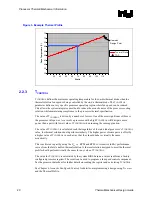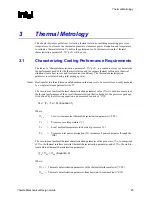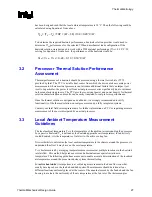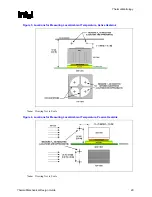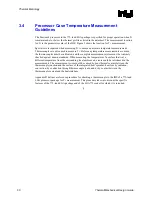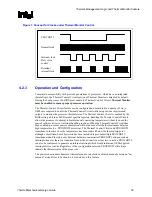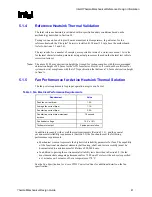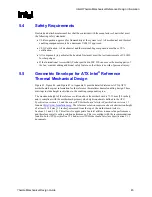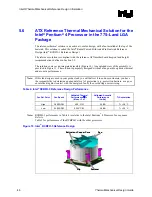
Thermal Management Logic and Thermal Monitor Feature
R
32
Thermal/Mechanical Design Guide
4.2.1 PROCHOT#
Signal
The Pentium 4 processor in the 775–land LGA package has a bi-directional PROCHOT#
capability to allow system designs to protect various components from over-temperature
situations. The PROCHOT# signal is bi-directional in that it can either signal when the processor
has exceeded its maximum operating temperature
or
be driven from an external source to activate
the TCC. The ability to activate the TCC via PROCHOT# can provide a means for thermal
protection of system components.
One application is the thermal protection of voltage regulators (VR). System designers can create
a circuit to monitor the VR temperature and activate the TCC when the temperature limit of the
VR is reached. By asserting PROCHOT# (pulled-low), which activates the TCC, the VR can cool
down as a result of reduced processor power consumption. Bi-directional PROCHOT# can allow
VR thermal designs to target maximum sustained current instead of maximum current. Systems
should still provide proper cooling for the VR, and rely on bi-directional PROCHOT# signal only
as a backup in case of system cooling failure.
The PROCHOT# signal is available internally to the processor as well as externally. External
indication of the processor temperature status is provided through the bus signal PROCHOT#.
When the processor temperature reaches the trip point, PROCHOT# is asserted. When the
processor temperature is below the trip point, PROCHOT# is de-asserted. Assertion of the
PROCHOT# signal is independent of any register settings within the processor. It is asserted any
time the processor die temperature reaches the trip point. The point where the Thermal Control
Circuit activates is set to the same temperature at which PROCHOT# asserts.
The temperature at which the PROCHOT# signal goes active is individually calibrated during
manufacturing. The power dissipation of each processor affects the set point temperature. The
temperature where PROCHOT# goes active roughly parallels the thermal profile. Once
configured the processor temperature at which the PROCHOT #signal is asserted is not re-
configurable.
Note:
A thermal solution designed to meet the thermal profile targets should rarely experience activation
of the TCC as indicated by the PROCHOT# signal going active.
4.2.2
Thermal Control Circuit
The Thermal Control Circuit portion of the Thermal Monitor must be enabled for the processor to
operate within specifications. The Thermal Monitor’s TCC, when active, will attempt to lower the
processor temperature by reducing the processor power consumption. This is done by changing
the duty cycle of the internal processor clocks, resulting in a lower effective frequency. When
active, the TCC turns the processor clocks off and then back on with a predetermined duty cycle.
The duty cycle is processor specific, and is fixed for a particular processor. The maximum time
period the clocks are disabled is ~3
μ
s. This time period is frequency dependent and higher
frequency processors will disable the internal clocks for a shorter time period. Figure 7 illustrates
the relationship between the internal processor clocks and the PROCHOT# signal.
Performance counter registers, status bits in model specific registers (MSRs), and the
PROCHOT# output pin are available to monitor the Thermal Monitor behavior.
Summary of Contents for 640 - Pentium 4 640 3.2GHz 800MHz 2MB Socket 775 CPU
Page 14: ...Introduction R 14 Thermal Mechanical Design Guide ...
Page 38: ...Thermal Management Logic and Thermal Monitor Feature R 38 Thermal Mechanical Design Guide ...
Page 52: ...Intel Thermal Mechanical Reference Design Information R 52 Thermal Mechanical Design Guide ...
Page 60: ...Acoustic Fan Speed Control R 60 Thermal Mechanical Design Guide ...
Page 72: ...Heatsink Clip Load Metrology R 72 Thermal Mechanical Design Guide ...
Page 99: ...Mechanical Drawings R Thermal Mechanical Design Guide 99 Figure 50 Reference Fastener Sheet 1 ...
Page 103: ...Mechanical Drawings R Thermal Mechanical Design Guide 103 Figure 54 Clip Heatsink Assembly ...



